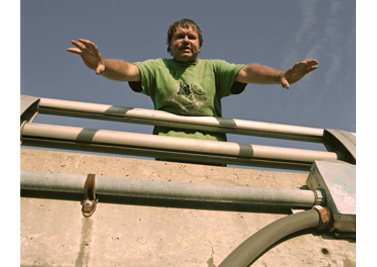Daniel Shea's series “Blisner, Ill.” portrays the crises of titanic mythologies.
Thoughts are the shadows of our feelings—always darker, emptier and simpler.
—Friedrich Nietzsche
Think different.
—Apple Computer
The first time I looked at a minimalist sculpture there was glue visible where two plexiglass edges met. It was jarring noticing something so base about an object that seemed so pure. It’s like the first time I saw a car accident victim, or the flailing of a half-stepped-on insect, or a smashed iPhone.
Much of the infatuation with Apple products comes from their industrial design: their apparent seamlessness as objects. We refrain from examining things too closely so that they appear simple, pure, comprehensible.
When we think of progress, we think of Bauhaus-inspired modernist design or clean
corporate advertising. When we think of nature, we think of the noble savage and the trend in contemporary food packaging of conflating “natural” with “clean and healthy.”
It’s easy to see the imperfections in these notions of purity: Industrialization’s massive
ecological disruption for example or, to quote Werner Herzog, the natural world’s “harmony of overwhelming and collective murder.”
The pictures that we see in Daniel Shea’s series “Blisner, Ill.” portray the crises of these
mythologies. It is a distant view into a blighted place. Shea’s pictures are complicated and convoluted. There is often a mist or materials blocking our view. Unkempt characters squint and avert their eyes. We peer over shoulders and around obstructions. Faded graffiti marks worn surfaces, and everywhere the irrepressible advance of flora and fauna erode the will-to-order of industry and civil engineering.
When a bridge gets built, the meaningful part of the bridge is the deck that connects two
otherwise inaccessible places. Whether the bridge is concrete or steel, supported by
suspension or trusses, it’s still a bridge. Its “bridgeness” derives from its quality of connecting two places. But building bridges also creates zones underneath where creatures seek shelter, hang out, and set stuff on fire.
Things often unite into ordered arrangements. In biological evolution, adaptation guides the
swirling flux of speciation. The result is the splendor of life. The built world is shaped by the action of humans. It produces the splendor that artists examine in their practices.
Daniel Shea is an artist based in Chicago. He recently exhibited sculptures and installations at LVL3 Gallery in Chicago and will be showing new photographs as part of a solo exhibition at the Museum of Contemporary Photography in October. He is currently in a long-term artist residency program at Columbia College Chicago working on his first monograph, Blisner, Ill. Daniel splits his time between working on the road or in the studio, completing a MFA at the University of Illinois at Chicago, teaching art courses, and taking assignments for publications including Dwell, The Fader, Wired, The Atlantic, TIME, and Monocle.

